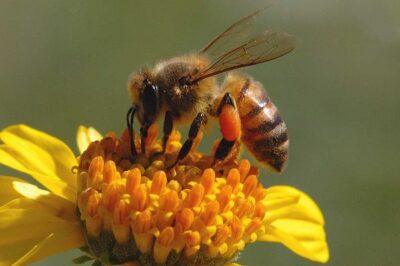|
Listen To The Article
|

Image source: beneficialbugs.org
Honeybees may get some much-needed help courtesy of a new protection plan under way in a western state – the first such colony collapse disorder [1] program in the nation.
North Dakota, which has been among the leaders in honey production in the United States for decades, has put together a “North Dakota Pollinator Plan” with a stated goal of decreasing the risks the honeybee population faces from the use of chemical pesticides and other agricultural production practices. The plan is voluntary but is being applauded by honeybee advocates.
It has multiple recommendations for beekeepers, landowners and pesticide users. For instance, it urges pesticide users to “identify and notify beekeepers in the area prior to pesticide applications” and to “apply pesticides early morning or in the evening.” It asks land owners to “work with beekeepers to choose hive locations.” It urges beekeepers to “notify landowners and applicators when arriving and when moving hives.”
North Dakota routinely boasts the production of approximately a half million hives per year – with the pollinators spending the winter in warmer climates. Even though beekeepers around the world experienced significant bee colony losses last year, North Dakota still managed to produce more than 34 million pounds of honey – approximately 23 percent of the honey produced in the United States.
The state is often referred to as the “last frontier” by beekeepers because it is one of the only places bees can relocate to in order to recover from the “stress of pollination services” and to acquire adequate foraging grounds. The resting period in the Western state is reportedly integral to their winter survival.
Order your 2014 Heirloom Solutions seed catalog and get $20 in your account!
Colony collapse disorder plagues not only America, but the bulk of nations around the globe. As previously reported by Off The Grid News, the decline of the honeybee population has often been blamed on GMO crops and chemical pesticides [2] manufactured by Monsanto [3] and other biotech giants. More than 90 crops grown in the United States require the aid of wild pollinators. Bee pollinated crops comprise up to 30 percent of the food eaten in America, according to USDA statistics – but many agriculture experts put the figure at closer to 70 percent.
North Dakota Agriculture Commission Doug Goehring said this about the Pollinator Plan:
It is completely non-regulatory. It contains best-management practices and other proactive measures and ideas to help agricultural producers and beekeepers find common ground, all on a voluntary basis. The guidelines will be revisited and annually and updated as needed.
The eight-page colony collapse disorder plan was drafted based upon information which sprang from extensive meetings with beekeepers, crop consultants, pesticide applicators and growers. The focus of the plan appears to be based on the need for increased cooperation among pesticide applicators, beekeepers, and landowners in order to protect the ever-decreasing honeybee population.
An excerpt from the North Dakota Pollinator Plan states:
Nationally, year to year colony survival is variable with some beekeepers reporting losses as high as 30 percent. Growers and pesticide users cannot help beekeepers manage threats from mites, beetles and the microbes that weaken their hives. They can, however, help with reducing their exposure to pesticides and improving the quality of forage available. Even though Varroa [mites are] considered the greatest threat to honey bee colonies, a strong colony can handle the pressures of this tiny creature better than one exposed to various pesticides and poor forage that weaken the hive. They [growers] must also consider timing of pesticide applications with respect to harvest and rotation intervals.
Off grid living [4] expert and beekeeper Rick Austin had this to say about the North Dakota plan and the overall issues associated with colony collapse disorder:
Guidelines are all well and good, and perhaps it is a step in the right direction. At least it is bringing awareness to the problem. But the real problem is GMO corn and soybeans that are spreading poison pollen everywhere through the wind. And as we have discussed in the past, the only way that the use of GMOs will stop, is to force companies like Monsanto to stop using it.
The National Association of State Departments of Agriculture called for the development of a formal honeybee protection plan, and North Dakota was the first to answer. If the state’s program is a success, it would likely serve as a model for the rest of America to follow.
Sign up for Off The Grid News’ weekly email and stay informed about the issues important to you [5]
